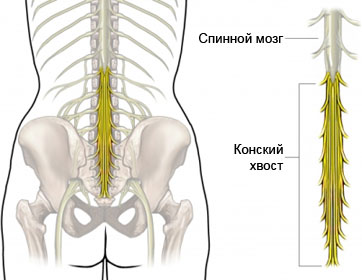Cauda equina syndrome – Compression of spinal nerve roots
Description of cauda equina syndrome
Cauda equina syndrome (CKX) there, when the nerve roots at the base of the spinal cord is compressed. Known as “ponytail”, This nerve center regulates feelings and bladder function, bowel, genital organs and legs. CKX is a medical emergency. If you do not reduce the pressure on the nerves, functioning of, below the belt, It may be lost.

Causes of cauda equina syndrome
CKX common cause is damage to the spinal disc, has an effect on the nerve roots. Spinal Disc – semi-soft mass of tissue, which is located between the bones of the spine – vertebrae. Discs act as “shock absorbers” bones of the spine. When the disc is pressed into the spinal canal, it can put pressure on nerves, causing CKX. This syndrome can also cause:
- Accident, accompanied by a spinal injury (eg, a car accident or a fall);
- Penetrating injuries (eg, stab or gunshot wound);
- Arthritis (eg, ankylosing spondylitis);
- Complications spinal anesthesia;
- Vascular lesions in the spinal cord (eg, blood clot);
- Complications from cancer;
- A side effect of medication.
Risk Factors cauda equina syndrome
Factors, which can cause cauda equina syndrome, They include:
- Back problems in the past (eg, poyasnychnыy spinal canal stenosis);
- Degenerative diseases of the spinal discs;
- Birth defects (eg, a narrow spinal canal, spina bifida);
- Bleeding, affecting the spinal cord;
- Arteriovenous malformations;
- Spinal surgery or spinal anesthesia;
- Lesions or tumors, affecting the bones of the spine or spinal fluid (CSF);
- Infection, affecting the spine;
- Maybe, Manipulation of the lower back (eg, massage).
If you have any of these risk factors, tell your doctor.
The symptoms of cauda equina syndrome
These symptoms, except cauda equina syndrome, They may be caused by other, less serious diseases. If you experience any of them, should see a doctor.
- Severe back pain;
- Numbness, tingling perineal (so-called saddle anesthesia / paresthesia);
- Inability to urinate, or retention of urine or faeces;
- Inability to walk or move the foot;
- Weakness, loss of sensation or pain in one or both legs;
- Sexual dysfunction (eg, inability to have an erection in men)
CKX requires emergency surgery. If you have any of the above symptoms, should seek emergency care.
Diagnosis of cauda equina syndrome
The doctor will ask about your symptoms and medical history, and perform a physical examination. He can hold a neurological examination, which includes testing reflexes, of view, mental state and physical strength. To assess the function of the sphincter may be carried rectal examination.
Diagnostic tests may include:
- MRT – test, which uses magnetic waves, to make pictures of the structure of the brain and spinal cord;
- CT scan – X-ray views, wherein the computer is used, to make pictures of the structure of the brain and spinal cord;
- Myelogram – test, which uses a special dye to take pictures of the spinal cord and the area around it;
- Rheotachygraphy – measures and records the electrical activity of muscles.
Upon detection of CKX may need urgent treatment.
Treatment of cauda equina syndrome
Treatment options include the cauda equina syndrome following:
- Surgical methods:
- Laminectomy – surgical procedure, which removes part of the vertebra, It called bow;
- Discotomy – how to delete that portion of the intervertebral disc, which puts pressure on the spinal cord or nerve roots;
- Radiation therapy – If CKX arose due to cancer, Radiation therapy may be one method of treatment.
The doctor may also prescribe the treatment of the disease, which causes CKX.
Aftercare at CKX
Long-term effects CKX can range from mild to severe. Problems can include:
- Difficulty walking;
- Problems with bladder and bowel;
- Sexual dysfunction;
- Paralysis.
To restore the functioning of the work may need the following doctors:
- Physiotherapist;
- Professional Adviser;
- Neurologist;
- Expert, learning to control incontinence (If you have lost bladder control).
Medication in the cauda equina syndrome
Your doctor may prescribe medication, to control:
- Pain;
- Problems bladder and bowel.
Prevention of cauda equina syndrome
There are no guidelines, allowing to prevent CKX.
